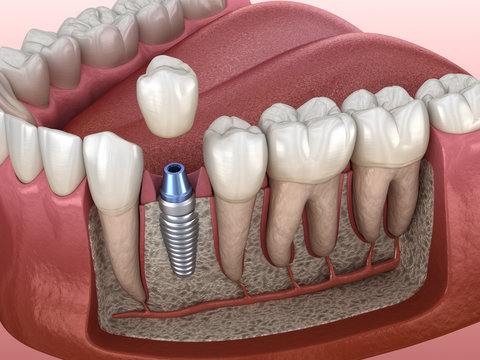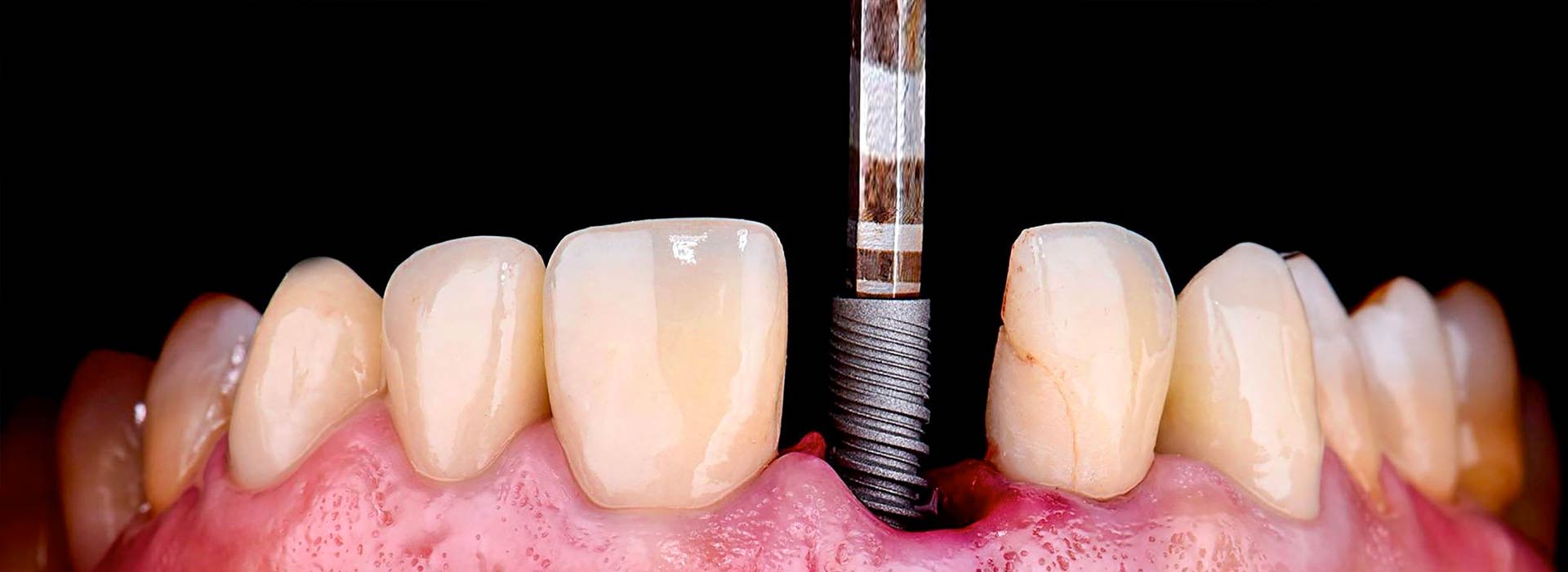DENTAL IMPLANT
What is Dental Implant?
 Dental Implant is the artificial tooth roots placed in the jawbone to restore the function and aesthetic of the missing teeth. Implants are the best alternative to natural teeth. They provide better speaking and chewing function than dental bridgework and prosthetics and help to achieve a more aesthetic appearance. With dental implants, patients are able to regain their comfort in life by having healthy and aesthetic artificial teeth instead of their missing natural teeth.
Dental Implant is the artificial tooth roots placed in the jawbone to restore the function and aesthetic of the missing teeth. Implants are the best alternative to natural teeth. They provide better speaking and chewing function than dental bridgework and prosthetics and help to achieve a more aesthetic appearance. With dental implants, patients are able to regain their comfort in life by having healthy and aesthetic artificial teeth instead of their missing natural teeth.
How to done Dental Implant?
Dental implants are small titanium screws that are fully compatible with the human body, function instead of natural teeth. These artificial tooth roots are used by complementing them with porcelain tooth made on them. Implant treatment can be easily applied in one or more teeth loss. The patient who has been treated for implants can return to normal life on the same day.
Correct diagnosis,proper size,correct choice of implant and surgical technique are very important in the success of the dental implant. Accurate diagnosis and proper implant selection should be done by examining the patient’s 3D jaw images. At the same time, clinical examination by the surgeon is very important. After the appropriate implant and appropriate technical selection, surgical procedure can be performed.
Implant surgery is started in a clinical area by local anesthesia. In addition to local anesthesia, sedation can be performed in cases where multiple procedures are performed at the same time, in patients who are concerned about surgery or at preferred times by the surgeon. Sedation allows patients to go to sleep with an intravenous drug accompanied by an anesthesiologist and not to hear the procedures performed and not to remember afterwards.
After anesthesia, a small pilot hole is opened to the jawbone by opening the gingiva in the area where the implant will be made.The pilot hole is then expanded slowly and the implant is placed to suit the form. The traumatic effect on the bone is also reduced by gradually expanding the hole in the jawbone. Then the implant is inserted into the gap opened in the jawbone by screwing. In multi-implant surgery or in situations where the surgeon prefers, implant guidelines prepared with 3D modeling are used. These guidelines ensure that implants are re-placed without errors and in a short time.
After the placement of implants, a protective cap screw is placed on the implant to provide osseointegration in the area (the implant’s integration with the jawbone) and to wait for the implant area to heal. The opened gingiva is sewn and closed and a waiting process is initiated for several months. After a few months, the protective screw is removed and the healing cap is placed on the dental implant. This title serves as a template where gingiva can naturally shape and grow around. After the gingiva is shaped, prosthetic procedures are performed and the temporary structure the treatment is completed by changing it with permanent curone (porcelain or zirconium tooth).
Can dental implants be done to everyone?
Implants can be performed in cases such as loss of tooth, multiple teeth and total toothlessness, except for some health problems.
Radiological and clinical examinations are carried out in the region where the implant will be applied first in order to apply the implant in a healthy way; By examining the bone and density of the region and the condition of the adjacent anatomical regions, it can be decided whether the implant construction is appropriate.
Except for regional eligibility; affecting the construction of implants other situations include:
In patients with high smoking consumption;
Smoking can adversely affect the implant’s integration with the bone, depending on carbon monoxide and toxic effects. It also has negative effects such as delaying wound healing and reducing blood build up. In this case, if your doctor approves, implants can be made by reducing smoking before and after implant.
Note: It is especially recommended that smoking implant patients,quit smoking 15 days before treatment and for up to 1 month after treatment.
In diabetics;
Implant construction may be risky in patients with diabetes who are not under control. Tissue healing in diabetes patients is low, but the risk of infection increases.
Implants can be made for patients whose blood sugar level is under control. It is very important to provide oral hygiene for diabetics after implant treatment is completed. Diabetes patients should not disrupt periodic dentist checks.
In patients with heart problems;
Dental implants can be performed safely after consultation with the cardiologist in patients with heart disease.
In patients with hypertension;
Patients with high blood pressure in cases such as pain and stress, there is an overreaction, when overreacted to stimuli, blood pressure may increase acutely during dental treatment and various complications may occur. For this reason, you can use the Before starting dental treatment of patients with hypertension, blood pressure measurements should be performed, doctor consultative should be preferred.
Blood Coagulation Disorders
Implant surgery is a risky procedure in patients with blood coagulation disorders. Necessary doctor consultations should be made.
How long will the implant heal?
After implants are placed in the jawbone, and after the effect of anesthesia has passed, the patient can start eating and return to normal life. After the procedures, it is very important to pay attention to what the doctor says and warnings. If the patient has applied completely what physician said, there will be no problems. Within a week, the seams are removed and osseointegration time is expected.
In order to make the upper structure of the implants, it is necessary to wait between 2-3 months. The purpose of this wait is to ensure the integration of the bone and titanium implant. In this process, the jawbone adheres to the roughened surface of the implant. After wrapping the titanium in the jawbone, the implant is fixed in place.
The waiting times mentioned above may decrease to a month for some special implants. Like the quality of the implant, the quality of the jawbone changes the waiting period. Smoking habit also negatively affects treatment by prolonging the waiting time. Other factors relate to the success of the physician and how much the patient complied with the recommendations after the implant procedure.
Implant Brands and Importance;
Nowadays, the number of known implant brands is over 500. Again, these implant brands use nearly 100 different designs in their production.
Some brands are the leading brands that stand out with their innovative designs on high r&d budgets. These brands produce implants that offer convenience to patients and physicians through the high budgets they allocate to research and development projects. These implants give the patient an advantage thanks to their rapid healing process, while also offering the dentist convenience and robustness with more advanced connection shapes to add superstructures.
Others are brands that use relatively old technology with no r&d expenses. For this reason, there are many different implant quality and prices.

How long does the dental implant treatment take?
We can examine the duration of Implant treatment under two headings:
1) Surgical procedure time
2) Waiting time after surgery
1) Surgical procedure time:
If a single implant is to be performed, this procedure period varies from 10 to 30 minutes. The duration of implant treatment may vary from half to several hours depending on the number of implants to be performed and the patient’s jawbone.
2) Waiting time after surgery
This period usually varies between 2 to 3 months. Implants placed in the jawbone adhere to the bone during this time, completing the osseointegration process.
After this process is completed, the stage of prosthetic operations, which will take approximately 1-2 weeks, is started.
Apart from these, there are very advanced systems in which the upper structure,that is to say the teeth,can be fitted on the same day with implants.
Your doctor may recommend these specific systems if he sees fit.
Will I be in pain during dental implant?
Before the implant operation, which is a surgical procedure, local anesthesia is applied to the patient. Therefore, during the surgical procedure, the patient does not feel pain or ache in any way.
Patients undergoing implant therapy may have mild pain after the effects of anesthesia. These pains should be accepted normal. This condition can be alleviated by using medications recommended by your doctor after the operation.
In operations with sedation or under general anesthesia, the operation is completed painlessly and without worry.
What should be considered after implant surgery?
Nothing should be eaten until at least 3 hours after the operation.
Bleeding Control
1) After tooth extraction, bite the tampon firmly placed in your mouth for 30 minutes.
2) Do not spit strongly and take care not to irritate the wound area. Avoid talking as possible.
3) Do not smoke until 3 days after the operation. Smoking will disrupt healing and prevent bleeding to stop.
4) Preferably rest after surgery. Put a few pillows under your head and lie with your head up.
5) Bleeding in the form of leakage can continue for a while. Eski tamponu çıkarın ve yeni tamponu veya ıslatılmış çay poşeti yerine koyarak 20 dakika ısırın. This can be repeated 3-4 times.
6) There may be discoloration of the saliva as a result of bleeding in the form of leakage.
Oral Hygiene
1) Do not use mouthwash for 12 hours after the operation.
2) After 12 hours, start gargling by stirring half a teaspoon of salt into a cup after each meal. This process will speed up the healing.
3) Continue brushing your teeth regularly, provided that you are more careful and kind in the operation area.
4) After meals, clean the seams with wet tampons to prevent the accumulation of food residue.
Swelling
Swelling or bruising may occur after the operation. on the first day,apply an ice bag for 10 min to the side where the tooth is pulled and wait for 5 min; It will minimize the amount of swelling. Swelling will disappear in a week. The bruising will disappear spontaneously within 7-10 days.
Drug Utilization
1) Aspirin will increase bleeding; if you have pain, it is recommended to take non-aspirin painkillers.
2) Antibiotics can be given as precaution for the development of an infection.
3) Use all drugs in accordance with the instructions given to you during the recommended period of recommended doses.
4) Mouthwash exposed with antiseptic properties should be kept in the mouth for 3-4 minutes, then should not be shaken with water.
Nutrition
1) Eat more liquid and soft foods. Avoid foods and drinks that are carbonated, acidic, very hot and cold.
2) Absolutely don’t drink alcohol.
3) Avoid chewing with the side where the tooth is pulled.
4) You can go back to your usual nutrition in a few days but be careful to take plenty of fluids.
Sutures
Be careful not to irritate the sutures especially with the tongue.Be sure to have your stitches removed after 7-10 days.
Control
Make sure you go to your check-in appointment.
How long does implants last?
What is the life span of dental implants?
Life span of dental implants are depends on many factors. At the beginning of these are the correct diagnosis, planning and surgical technique. When determining the location of the implant, the quality of the bone, the size and shape of the implant, the diagnostic methods used by the surgeon are as important as the experience. Especially 3D imaging, biomodel and implant guideline technologies have greatly increased the success rate. In addition, the brand and quality of the implant used, the planning and quality of the tooth structures above the implant directly affect the life span of the implant.
Another factor that determines the life span of dental implants is the patient’s oral and dental care. Although implants are metal, what keeps the implant in place is the health of the surrounding bones and gingiva. In a uncared mouth, implants have no chance of longevity.
When all these conditions are applied, it has been observed that implants can remain in the mouth for 30-40 years or even a lifetime. Cigarette and alcohol use are factors that adversely affect the process. Gingival disease and other disorders affecting bone quality can significantly reduce implant life span. Implant treatment,which is done correctly with good planning, is one of the most important factors that increases implant life span. The only criteria for successful implant treatment is not to ensure that the implant will bonding with bone at the end of the required waiting period, but also to prevent mid-and long-term problems that may arise due to incomplete planning in the implant area.
In order to extend the life span of the implant, the patient must go to annual physician checks. Early diagnosis and treatment of problems/diseases that may occur in the teeth, gingiva and bone surface can ensure that the implant remains in the mouth for many years.
Another point to consider is that the life of the implant and the life span of the prosthesis on the implant may be different. Even if there is no problem with the implant, there may be a problem with the prosthesis made on the implant and the prosthesis may need to be repaired or replaced. Prosthetic and implant are two parts that interact with each other but are independent of each other. In a mouth where the implant is intact, the prosthesis on the implant can be repaired or replaced without problems.
